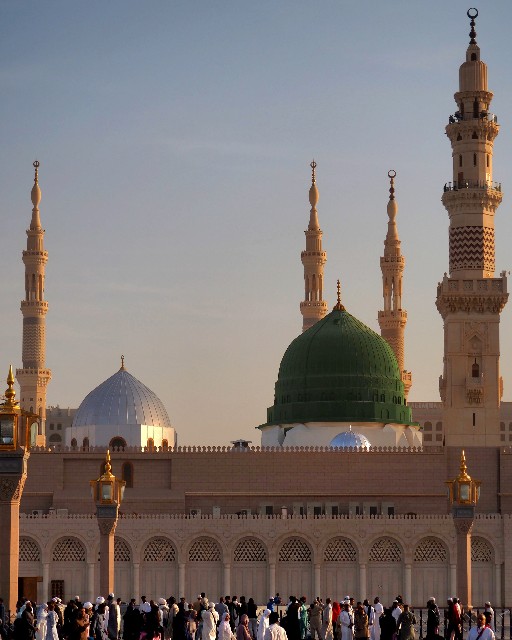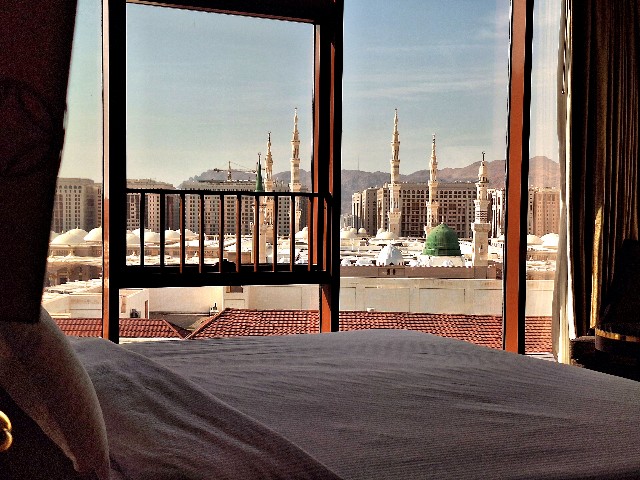Medina, Saudi Arabia, is known as a holy site in Islam. The area centered around the Prophet Muhammad’s Mosque is a sacred zone with special meaning for Muslims, and non-Muslims are prohibited from entering. However, there has been no accurate documentation showing exactly where non-Muslims are allowed to approach.

According to online information, many sources state that non-Muslims cannot enter inside this green line, but is that really true…?
Information about access restrictions in Medina is confusing online. Various theories circulate, from “non-Muslims can go anywhere except the area enclosed by the green gates” to “the entire area inside the First Ring Road is off-limits.” Some posts even cause anxiety by claiming that “even if you book a hotel inside the First Ring Road, you won’t actually be able to stay there.”
To verify these claims, I actually visited Medina and set out to discover the boundaries of the “areas accessible to non-Muslims” with my own feet. In this article, I’ll share those experiences and discoveries in detail.
On-Site Verification: To the Center of Medina
From AlUla to Medina

My journey started from AlUla (Ula), a town of ancient ruins in northwestern Saudi Arabia. (I traveled from AlUla to Medina by overnight bus, but for details on that, please refer to my previous article)
Early in the morning, I arrived at a bus stop near Mount Uhud on the outskirts of Medina. From there, I took a taxi and headed toward the center of Medina.
Inside the First Ring Road

The moment I saw the Prophet’s Mosque from the car, my excitement immediately rose
The taxi entered inside the First Ring Road (officially named King Faisal Road) without hesitation. When I asked the driver, “Is it okay for non-Muslims to enter this area?” he replied, “Of course.” At this point, I realized that, at the very least, the First Ring Road area was not completely off-limits.
Around the Prophet’s Mosque

View of the Prophet’s Mosque from the north
The taxi stopped near the Clock Roundabout (a circular intersection with a clock tower) on the north side of the Prophet’s Mosque. From here, I decided to walk toward the mosque. Heading south along the pedestrianized street, I could see the green fence surrounding the mosque area.

Looking at the compound, I saw a vibrant green fence. Is this the so-called green gate?
Wondering if this was the green gate marking the restricted area, I continued walking straight ahead to see if I could proceed that far.
The Boundary of the Non-Muslim Restricted Area
As I continued walking, I made eye contact with a police officer who was providing security nearby. Just to be safe, I mustered my courage and asked, “Can I go further ahead?”
However, the police officer politely declined: “Unfortunately, non-Muslims cannot enter further inside.” But he did point to the gate marking the sacred area and explained that as long as I didn’t cross the gate, walking around the perimeter was not a problem.

This is the correct green gate. It’s a deeper green color than I expected. Some sections are wide open as entrances.
I was a bit nervous as I had almost violated a taboo. Following the police officer’s instructions, I decided to view the sacred area from in front of the green gate.

The green gate can be seen on the left side. The poles lined up at the bottom of the photo mark the sacred area line.
Interestingly, I discovered that the vibrant green fences visible inside the mosque grounds were actually for traffic control within the mosque. These were unrelated to the non-Muslim access restrictions.
Characteristics of the Mosque Surroundings

A plaza stretches on the west side of the Prophet’s Mosque
Having received permission from the police officer, I decided to walk counterclockwise around the mosque. Walking around, the “borderline” for non-Muslims became clear. Indeed, the green gates seemed to function as the boundary line for the restricted area. However, I found that this boundary isn’t a simple rectangle – it has a somewhat complex shape depending on the location.

The south side is the front of the mosque. The gates are wide open, making it a perfect photo spot.
What’s notable is the east side of the mosque. On the east side, you cannot walk along the mosque grounds as you can on the other sides. Instead, you need to take a wide detour along the First Ring Road (King Faisal Road). This detour route includes areas that are currently under development, requiring you to go around this part of the mosque complex in a wide arc.

The restricted area line becomes complex on the east side of the mosque
Also on the east side, there’s an observation area (a slope you can climb to look down on the mosque). Non-Muslims can enter this area, but there’s an important restriction. When I took out my camera here, I was immediately cautioned by a police officer. Apparently, photography is prohibited in this location. However, photography was permitted in other areas.
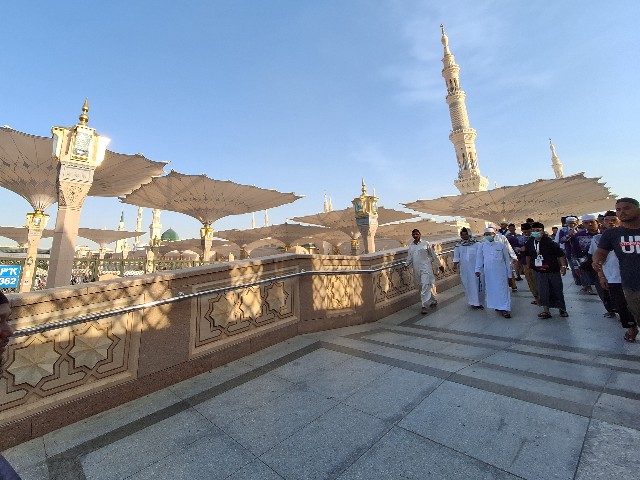
Climbing these stairs leads to the observation area. I’m not sure of the exact reason, but I was warned when taking photos in the observation area.
Cemetery Area
Separate from the mosque’s sacred zone, there’s another important restricted area. That’s the cemetery area to the east, adjacent to the mosque. Known locally as Al Baqi Cemetery, this place is also off-limits to non-Muslims.
So the access restrictions that non-Muslims should be aware of in central Medina are:
- 1. No entry to the sacred area centered around the mosque
- 2. No entry to the Cemetery area
- 3. No photography in the observation area on the east side of the mosque

I discovered that while restricted areas certainly exist, they are narrower than I had expected.
Temporary Restrictions Due to Road Construction
Furthermore, there may be temporary access restrictions depending on when you visit. For example, major road construction sometimes takes place on Abu Ayyub Al-Ansari Road, particularly in the southern part of the Cemetery. During construction, the general public may not be able to enter these areas, so caution is necessary.
If you encounter such a situation, you’ll need to detour outward to the First Ring Road (King Faisal Road). Since construction conditions can change daily, it’s important to follow local guidance and instructions.
Staying at a Hotel Inside the First Ring Road
After completing my local investigation, I checked into a hotel called “Pullman Zamzam Madinah” inside the First Ring Road without any issues. Contrary to some information on the internet, I confirmed that non-Muslims can indeed stay at hotels in this area without problems.
Summary: Non-Muslim Access Restrictions in Medina
Based on this on-site investigation and additional information, the following has become clear regarding non-Muslim access restrictions in Medina:
- 1. The main restricted areas are the Prophet’s Mosque grounds and the Al Baqi Cemetery area.
- 2. The east side of the mosque has a unique shape, requiring a wide detour along the First Ring Road (King Faisal Road).
- 3. Non-Muslims can freely access most places inside the First Ring Road.
- 4. Clear boundary lines (green gates) are established around the mosque, and wandering around is possible as long as you don’t cross them.
- 5. Photography is prohibited in the observation area on the east side of the mosque, so be careful.
- 6. Road construction may be taking place around Abu Ayyub Al-Ansari Road, and access may be temporarily restricted.
- 7. Non-Muslims can stay at hotels inside the First Ring Road without issues.
In conclusion, the restricted areas for non-Muslims in Medina are not as extensive as some internet information suggests, but they do have complex shapes in some places. There’s also the possibility of areas becoming inaccessible due to temporary factors like construction. If you have concerns, the most reliable method is to check with local police officers or staff. They are generally friendly and will provide appropriate guidance.
Finally, the situation in Medina may change over time. Access to certain areas may change, especially in regions undergoing major development or renovation. Therefore, I recommend checking the latest information before your visit and always paying attention to your surroundings while there.
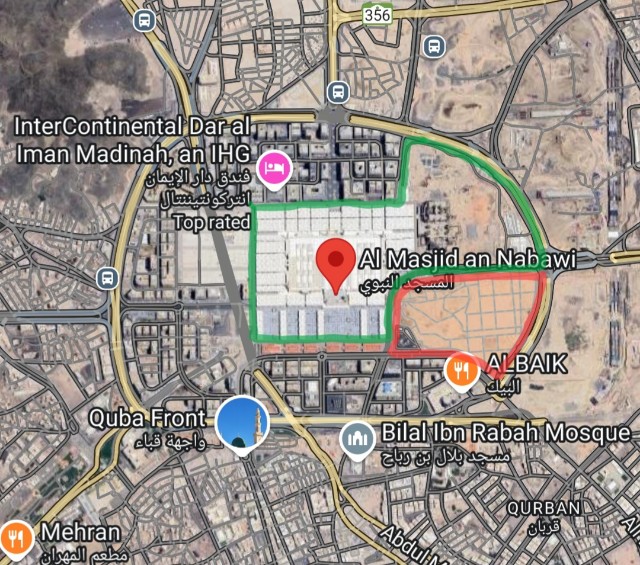
Summarizing the verification results, I found that non-Muslims cannot enter the green line (sacred area) and the red line (Cemetery) on this map.
![[World’s First Dragon Ball Theme Park] Shenron Descends in Saudi Arabia! Opening Dates, Construction Site, and Prices Revealed](https://en.kosupatravel.com/wp-content/uploads/2024/12/20240328093236-1024x576.png)
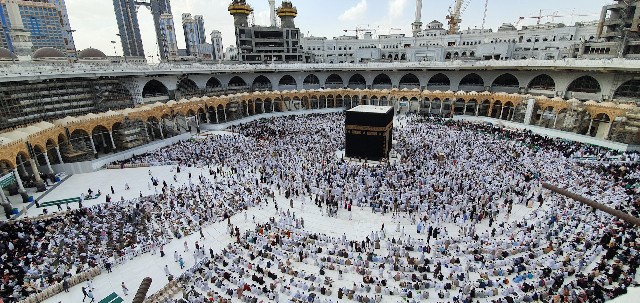
![Tasting the Sacred Water from Mecca’s Zamzam Well! Flavor, Benefits, and How to Get It [Zamzam Water Review]](https://en.kosupatravel.com/wp-content/uploads/2025/03/20240717185410.jpg)
